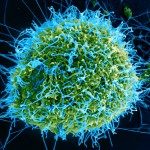Lien vers Pubmed [PMID] – 25505242
J. Biol. Chem. 2015 Feb;290(8):4631-46
After cell entry, HIV undergoes rapid transport toward the nucleus using microtubules and microfilaments. Neither the cellular cytoplasmic components nor the viral proteins that interact to mediate transport have yet been identified. Using a yeast two-hybrid screen, we identified four cytoskeletal components as putative interaction partners for HIV-1 p24 capsid protein: MAP1A, MAP1S, CKAP1, and WIRE. Depletion of MAP1A/MAP1S in indicator cell lines and primary human macrophages led to a profound reduction in HIV-1 infectivity as a result of impaired retrograde trafficking, demonstrated by a characteristic accumulation of capsids away from the nuclear membrane, and an overall defect in nuclear import. MAP1A/MAP1S did not impact microtubule network integrity or cell morphology but contributed to microtubule stabilization, which was shown previously to facilitate infection. In addition, we found that MAP1 proteins interact with HIV-1 cores both in vitro and in infected cells and that interaction involves MAP1 light chain LC2. Depletion of MAP1 proteins reduced the association of HIV-1 capsids with both dynamic and stable microtubules, suggesting that MAP1 proteins help tether incoming viral capsids to the microtubular network, thus promoting cytoplasmic trafficking. This work shows for the first time that following entry into target cells, HIV-1 interacts with the cytoskeleton via its p24 capsid protein. Moreover, our results support a role for MAP1 proteins in promoting efficient retrograde trafficking of HIV-1 by stimulating the formation of stable microtubules and mediating the association of HIV-1 cores with microtubules.


